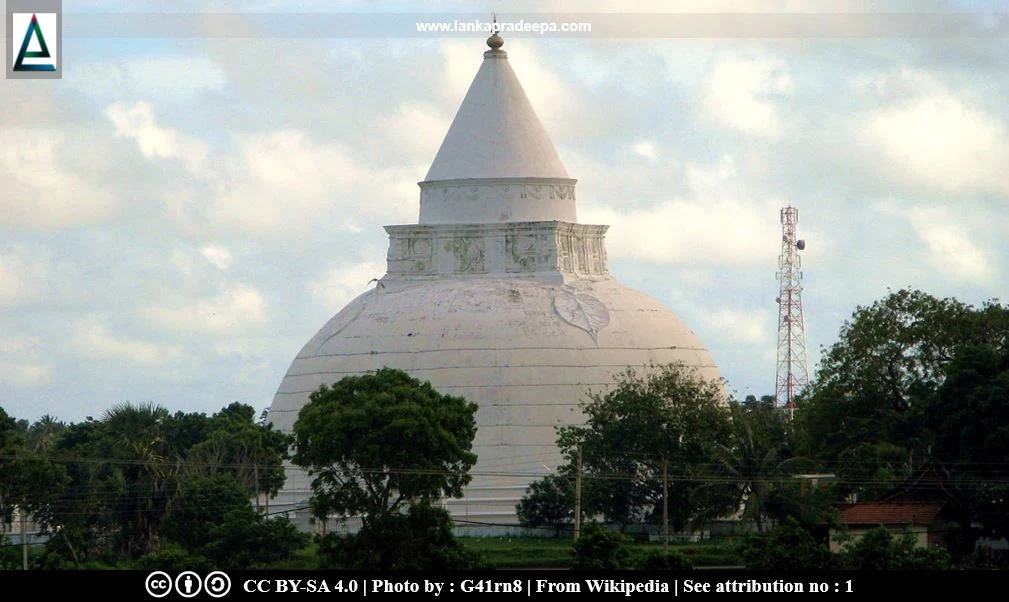
|
Tissamaharama Stupa |
Tissamaharama Viharaya, also known as Tissamaha Vihara, Tissarama (Sinhala: තිස්සමහාරාම රජ මහා විහාරය), is a Buddhist temple situated in the vicinity of Tissa Wewa in Hambantota District, Sri Lanka. Buddhist devotees highly venerated it as one of the sixteen sacred places in the country where the Buddha is supposed to have visited (Abeyawardana, 2004).
History
Tissamaharama Viharaya was founded by King Kavantissa (205-161 B.C.) along with the Silapassaya Pirivena (Nicholas, 1963). It is said that Prince Dutugemunu (reigned: 161-137 B.C.) made an offering at Tissamaha Vihara before setting out on his campaign against King Elara [(205-161 B.C.) Nicholas, 1963]. The chronicle Mahavamsa states that during the reign of King Ilanaga (35-44 A.D.) the Stupa was enlarged and restored (Abeyawardana, 2004). Subsequently, the Stupa was restored during the reigns of King Voharikatissa (215-237 A.D.) and King Vijayabahu I [(1055-1110A.D.) Abeyawardana, 2004].
Inscriptions
This temple is believed to have been recorded by the names Akuju Mahagama or Akujuka in the two inscriptions of the 2nd century A.D. discovered from Situlpawwa and Kataragama (Nicholas, 1963; Paranavitana, 1983; Paranavitana, 2001). An inscription by King Mahanama (406-428 A.D.) mentions this temple as Mahagama Rajamaha Vehera and it reveals that a large extent of land at Palitotugama was donated to the temple (Nicholas, 1963). In the 7th century, King Dappula (circa.659 A.D.) donated the village of Kattikapabbata to this temple (Nicholas, 1963). The Kirinda pillar inscription of Kassapa V (898-914 A.D.) mentions this temple as Tisaram-rad Mahavehera built by King Kavantissa after his own name (Ranawella, 2001). In the Kataragama-Detagamuwa inscription of King Dappula IV (923-935 A.D.), this temple has been referred to as Mahaveher (Nicholas, 1963; Paranavitana, 1933).
Controversy over the Tooth Relic of the Buddha
Some believe that the left Tooth Relic of the left jaw of the Buddha is enshrined in this Stupa (Abeyawardana, 2004). This belief became popular after the Kirinda pillar inscription of Kassapa V was discovered in 1960 at a place named Galkanda, a mile north of the Kirinda Viharaya (Ranawella, 2001). As to the reading and interpretation of this inscription by C.E. Godakumbura, the Stupa of Tissamahara Vihara has been built by Kavantissa over the relic of the left tooth of the lower jaw of the Buddha (Ranawella, 2001). However, later, by correcting some readings by Godakumbura, Dr. Ranawella pointed out that the Tissamaharama Stupa hadn't been built over the Tooth Relic of the left lower jaw of the Buddha, but actually the tooth relic had been conveyed by the king for veneration during a particular ceremony of constructing a large Stupa at a place where the relics of the three former Buddhas had been enshrined (Ranawella, 2001).
The Stupa
Tissamaharama can be considered as the one that started the tradition of building mega Stupas in Sri Lanka (Ranaweera, 2004). The pot-shaped Stupa is 45.9 m tall and its dome has a diameter of about 43 m (Ranaweera, 2004).
Restoration
The restoration of the dilapidated Tissamaharama Stupa which had been swallowed by jungle for centuries was started by Wepathaira Sumana Thera who visited the site in 1853 (Ranasinha, 2021). A society named Tissamaharama Karya Sadaka Samithiya was formed in 1857 by him in order to re-erect the gigantic monument (Ranasinha, 2021). However, Sumana Thera died in 1873 before start the restoration works of the Hathares Kotuwa of the Stupa (Ranasinha, 2021). After that, Walpita Medhankara Thera took responcibilities and completed the restoration process by 1899 (Ranasinha, 2021). The erecting the pinnacle on the top the Stupa was done in 1900 (Ranasinha, 2021).
However, several vertical cracks were noticed on the surface of the dome towards its mid-height in the 1970s (Ranaweera & Silva, 2006; Silva, 2007). In order to halt the spread of these cracks and prevent the collapse of the dome, external pre-stressing was done using circumferential stainless steel cables fixed to the dome (Ranaweera, 2004; Ranaweera & Silva, 2006; Silva, 2007).
Related Posts
Read Also
References
Books, Journal Articles
1) Abeyawardana, H.A.P., 2004. Heritage of Ruhuna: Major natural,
cultural and historic sites. Colombo: The Central Bank of Sri Lanka.
ISBN: 955-575-073-4. pp.123-124.
2) Nicholas, C. W., 1963. Historical topography of ancient and medieval Ceylon. Journal of the Ceylon Branch of the Royal Asiatic Society, New Series (Vol VI). Special Number: Colombo. Royal Asiatic Society (Ceylon Branch). p.61.
3) Paranavitana, S., 1933. (Edited and translated by Wickremasinghe, D.M.D.Z.; Codrington, H.W.) Kataragama inscriptions.
Epigraphia Zeylanica: Being lithic and other inscriptions of Ceylon:
Vol. III. Printed at the Department of Government Printing, Sri Lanka
(Ceylon) for the Archeological Department. p.224.
4) Paranavitana, S., 1983. Inscriptions of Ceylon: Vol. II. Part I. Department of Archaeology, Sri Lanka. pp.95-96.
5) Paranavitana, S., 2001 (Edited by Dias, M.). Inscriptions of Ceylon: Vol. II. Part II. Archaeological Survey Department, Sri Lanka. pp.269-270.
6) Ranasinha, S., 2021. Tissamaharama urumaya narambamu (In Sinhala). Central Cultural Fund. ISBN: 978-955-613-324-0. pp.3-4.
7) Ranaweera, M.P., 2004. Ancient Stupas in Sri Lanka-Largest brick structures in the World. CHS Newsletter No. 70, December 2004, London, Construction History Society.
8) Ranaweera, M.P. and Silva, G., 2006. Conservation and Restoration of ancient stupas in Sri Lanka. Tenth East Asia-Pacific Conference on Structural Engineering & Construction–EASEC10. pp.1-6.
9 Ranawella, S., 2001. Inscription of Ceylon. Volume V, Part I. Department of Archaeology. ISBN: 955-9159-21-6. pp.358-362.
10) Silva, W.N.G., 2007. Conservation of ancient dagobas in Sri Lanka. Engineer: Journal of the Institution of Engineers, Sri Lanka, 40(3). pp.41-52.
Location Map
Dynamic Google Map
Attribution
To Whom
1) Tissamaharama Dagoba, 0648 by G41rn8 is licensed under CC BY-SA 4.0

